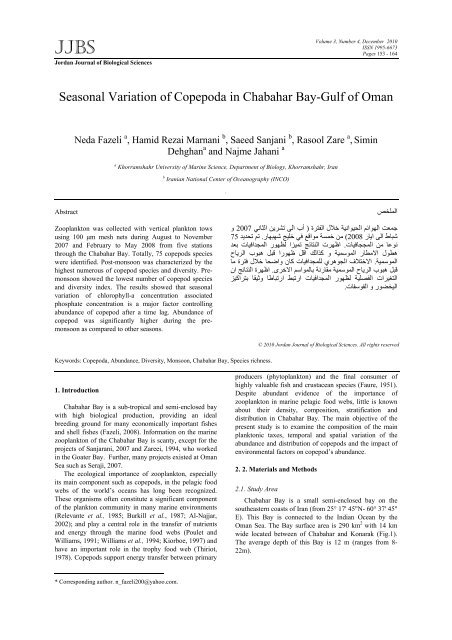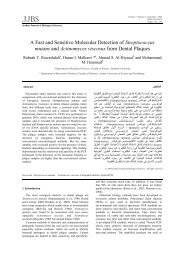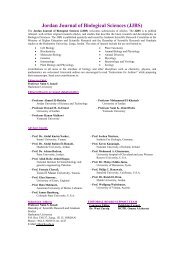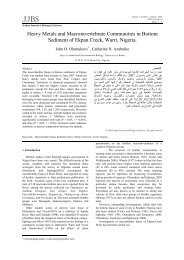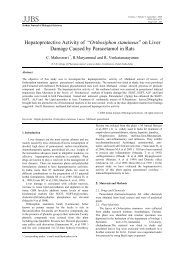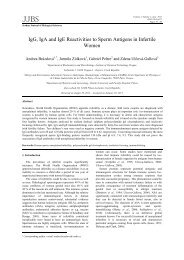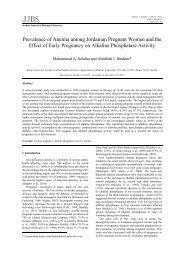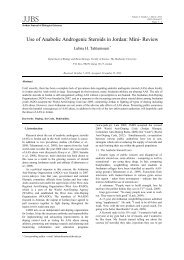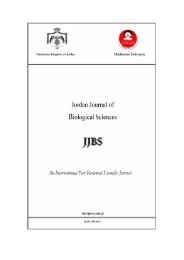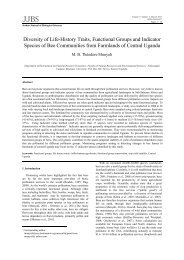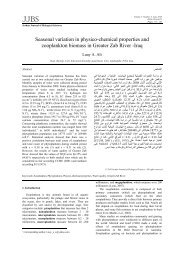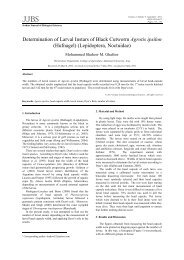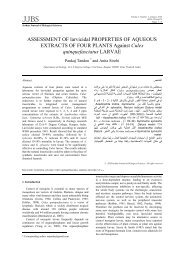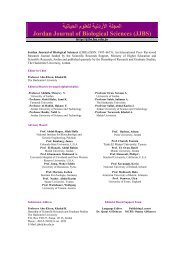Seasonal Variation of Copepoda in Chabahar Bay-Gulf of Oman
Seasonal Variation of Copepoda in Chabahar Bay-Gulf of Oman
Seasonal Variation of Copepoda in Chabahar Bay-Gulf of Oman
Create successful ePaper yourself
Turn your PDF publications into a flip-book with our unique Google optimized e-Paper software.
JJBS<br />
Jordan Journal <strong>of</strong> Biological Sciences<br />
Volume 3, Number 4, December 2010<br />
ISSN 1995-6673<br />
Pages 153 - 164<br />
<strong>Seasonal</strong> <strong>Variation</strong> <strong>of</strong> <strong>Copepoda</strong> <strong>in</strong> <strong>Chabahar</strong> <strong>Bay</strong>-<strong>Gulf</strong> <strong>of</strong> <strong>Oman</strong><br />
Neda Fazeli a , Hamid Rezai Marnani b , Saeed Sanjani b , Rasool Zare a , Sim<strong>in</strong><br />
Dehghan a and Najme Jahani a<br />
a Khorramshahr University <strong>of</strong> Mar<strong>in</strong>e Science, Department <strong>of</strong> Biology, Khorramshahr, Iran<br />
b Iranian National Center <strong>of</strong> Oceanography (INCO)<br />
.<br />
Abstract ﺺﺨﻠﻤﻟا<br />
Zooplankton was collected with vertical plankton tows<br />
us<strong>in</strong>g 100 μm mesh nets dur<strong>in</strong>g August to November<br />
2007 and February to May 2008 from five stations<br />
through the <strong>Chabahar</strong> <strong>Bay</strong>. Totally, 75 copepods species<br />
were identified. Post-monsoon was characterized by the<br />
highest numerous <strong>of</strong> copepod species and diversity. Premonsoon<br />
showed the lowest number <strong>of</strong> copepod species<br />
and diversity <strong>in</strong>dex. The results showed that seasonal<br />
variation <strong>of</strong> chlorophyll-a concentration associated<br />
phosphate concentration is a major factor controll<strong>in</strong>g<br />
abundance <strong>of</strong> copepod after a time lag. Abundance <strong>of</strong><br />
copepod was significantly higher dur<strong>in</strong>g the premonsoon<br />
as compared to other seasons.<br />
Keywords: <strong>Copepoda</strong>, Abundance, Diversity, Monsoon, <strong>Chabahar</strong> <strong>Bay</strong>, Species richness.<br />
1. Introduction *<br />
<strong>Chabahar</strong> <strong>Bay</strong> is a sub-tropical and semi-enclosed bay<br />
with high biological production, provid<strong>in</strong>g an ideal<br />
breed<strong>in</strong>g ground for many economically important fishes<br />
and shell fishes (Fazeli, 2008). Information on the mar<strong>in</strong>e<br />
zooplankton <strong>of</strong> the <strong>Chabahar</strong> <strong>Bay</strong> is scanty, except for the<br />
projects <strong>of</strong> Sanjarani, 2007 and Zareei, 1994, who worked<br />
<strong>in</strong> the Goater <strong>Bay</strong>. Further, many projects existed at <strong>Oman</strong><br />
Sea such as Seraji, 2007.<br />
The ecological importance <strong>of</strong> zooplankton, especially<br />
its ma<strong>in</strong> component such as copepods, <strong>in</strong> the pelagic food<br />
webs <strong>of</strong> the world’s oceans has long been recognized.<br />
These organisms <strong>of</strong>ten constitute a significant component<br />
<strong>of</strong> the plankton community <strong>in</strong> many mar<strong>in</strong>e environments<br />
(Relevante et al., 1985; Burkill et al., 1987; Al-Najjar,<br />
2002); and play a central role <strong>in</strong> the transfer <strong>of</strong> nutrients<br />
and energy through the mar<strong>in</strong>e food webs (Poulet and<br />
Williams, 1991; Williams et al., 1994; Kiorboe, 1997) and<br />
have an important role <strong>in</strong> the trophy food web (Thiriot,<br />
1978). Copepods support energy transfer between primary<br />
* Correspond<strong>in</strong>g author. n_fazeli200@yahoo.com.<br />
و 2007 ﻲﻧﺎﺜﻟا ﻦﻳﺮﺸﺗ ﻰﻟا بأ ) ةﺮﺘﻔﻟا لﻼﺧ ﺔﻴﻧاﻮﻴﺤﻟا ﻢﺋاﻮﻬﻟا ﺖﻌﻤﺟ<br />
75 ﺪﻳﺪﺤﺗ ﻢﺗ . رﺎﻬﺒﻬﺷ ﺞﻴﻠﺧ ﻲﻓ ﻊﻗاﻮﻣ ﺔﺴﻤﺧ ﻦﻣ ( 2008 رﺎﻳا ﻰﻟا طﺎﺒﺷ<br />
ﺪﻌﺑ تﺎﻴﻓاﺪﺠﻤﻟا رﻮﻬﻈﻟ اﺰﻴﻤﺗ ﺞﺋﺎﺘﻨﻟا تﺮﻬﻇا . تﺎﻴﻓﺎﺠﺠﻤﻟا ﻦﻣ ﺎﻋﻮﻧ<br />
حﺎﻳﺮﻟا بﻮﺒه ﻞﺒﻗ ارﻮﻬﻇ ﻞﻗا ﻚﻟاﺬآ و ﺔﻴﻤﺳﻮﻤﻟا رﺎﻄﻣﻻا لﻮﻄه<br />
ﺎﻣ ةﺮﺘﻓ لﻼﺧ ﺎﺤﺿاو نﺎآ تﺎﻴﻓاﺪﺠﻤﻠﻟ يﺮهﻮﺠﻟا فﻼﺘﺧﻻا<br />
. ﺔﻴﻤﺳﻮﻤﻟا<br />
نا ﺞﺋﺎﺘﻨﻟا ةﺮﻬﻇا . ىﺮﺧﻻا ﻢﺳاﻮﻤﻟﺎﺑ ﺔﻧرﺎﻘﻣ ﺔﻴﻤﺳﻮﻤﻟا حﺎﻳﺮﻟا بﻮﺒه ﻞﺒﻗ<br />
ﺰﻴآاﺮﺘﺑ ﺎﻘﻴﺛو ﺎﻃﺎﺒﺗرا ﻂﺒﺗرا تﺎﻴﻓاﺪﺠﻤﻟا رﻮﻬﻈﻟ ﺔﻴﻠﺼﻔﻟا تاﺮﻴﻐﺘﻟا<br />
. تﺎﻔﺳﻮﻔﻟا و رﻮﻀﺨﻴﻟا<br />
© 2010 Jordan Journal <strong>of</strong> Biological Sciences. All rights reserved<br />
producers (phytoplankton) and the f<strong>in</strong>al consumer <strong>of</strong><br />
highly valuable fish and crustacean species (Faure, 1951).<br />
Despite abundant evidence <strong>of</strong> the importance <strong>of</strong><br />
zooplankton <strong>in</strong> mar<strong>in</strong>e pelagic food webs, little is known<br />
about their density, composition, stratification and<br />
distribution <strong>in</strong> <strong>Chabahar</strong> <strong>Bay</strong>. The ma<strong>in</strong> objective <strong>of</strong> the<br />
present study is to exam<strong>in</strong>e the composition <strong>of</strong> the ma<strong>in</strong><br />
planktonic taxes, temporal and spatial variation <strong>of</strong> the<br />
abundance and distribution <strong>of</strong> copepods and the impact <strong>of</strong><br />
environmental factors on copepod’s abundance.<br />
2. 2. Materials and Methods<br />
2.1. Study Area<br />
<strong>Chabahar</strong> <strong>Bay</strong> is a small semi-enclosed bay on the<br />
southeastern coasts <strong>of</strong> Iran (from 25° 17' 45"N- 60° 37' 45"<br />
E). This <strong>Bay</strong> is connected to the Indian Ocean by the<br />
<strong>Oman</strong> Sea. The <strong>Bay</strong> surface area is 290 km 2 with 14 km<br />
wide located between <strong>of</strong> <strong>Chabahar</strong> and Konarak (Fig.1).<br />
The average depth <strong>of</strong> this <strong>Bay</strong> is 12 m (ranges from 8-<br />
22m).
154<br />
© 2010 Jordan Journal <strong>of</strong> Biological Sciences. All rights reserved - Volume 3, Number 4<br />
Figure 1. Sampl<strong>in</strong>g stations <strong>in</strong> the <strong>Chabahar</strong> <strong>Bay</strong>-<strong>Oman</strong> Sea
2.2. Sampl<strong>in</strong>g<br />
© 2010 Jordan Journal <strong>of</strong> Biological Sciences. All rights reserved - Volume 3, Number 4<br />
Four sampl<strong>in</strong>g cruises were carried out <strong>in</strong> August<br />
2007 (SW-monsoon), November 2007 (post-monsoon),<br />
February 2008 (NE-monsoon), and May 2008 (premonsoon).<br />
Five stations were <strong>in</strong>vestigated throughout the<br />
<strong>Chabahar</strong> <strong>Bay</strong>. Two stations (St. 1 and 2) were located far<br />
from shore waters with 22 m depth, another two stations<br />
were near the shore with 6m depth (St. 3 and 5) and the<br />
f<strong>in</strong>al station (St. 4) was located <strong>in</strong> the middle <strong>of</strong> the bay<br />
with 12m depth. Zooplankton was collected by us<strong>in</strong>g 100-<br />
µm mesh nets equipped with Hydrobios flow meter, from<br />
near the bottom to the surface at each station where<br />
physico-chemical variables were determ<strong>in</strong>ed. The samples<br />
were preserved immediately <strong>in</strong> 4-5% formal<strong>in</strong>, bufferered<br />
to a pH <strong>of</strong> 8 with sodim tetraborate (borax). Organisms<br />
were identified to groups and copepods to species level<br />
(whenever possible) and counted. Density was expressed<br />
as <strong>in</strong>dividuals per m - ³ (<strong>in</strong>dividual. m - ³).Only adult copepods<br />
were counted (Somoue et al., 2005).<br />
2.3. Data Analysis<br />
Species diversity was calculated us<strong>in</strong>g Shannon–<br />
Weaver diversity <strong>in</strong>dex (Shannon–Weaver, 1963) and<br />
Species richness (Margalef, 1968). The data were further<br />
subjected to hierarchical cluster and multidimensional<br />
scal<strong>in</strong>g (MDS) analyses to identify the similarity between<br />
stations based on composition <strong>of</strong> copepod species that<br />
were calculated as Braye Curtis similarity <strong>in</strong>dex us<strong>in</strong>g<br />
PRIMER (Clarke and Warwick, 1994).<br />
3. Results<br />
3.1. Environmental variables<br />
The mean <strong>of</strong> water temperature varied from<br />
(20.53 0.20°C) <strong>in</strong> NE-monsoon to (29.92 0.05°C) <strong>in</strong><br />
SW-monsoon. The mean <strong>of</strong> sal<strong>in</strong>ity ranged from<br />
(36.7 0.06 Psu) <strong>in</strong> SW-monsoon to (36.91Psu) <strong>in</strong> premonsoon<br />
(Fig.2b). The m<strong>in</strong>imum and maximum values <strong>of</strong><br />
chlorophyll-a concentrations were noticed (0.77 0.08<br />
mg. m־³) <strong>in</strong> SW-monsoon to (1.84 0.92 mg. m־³) <strong>in</strong> NEmonsoon<br />
(Fig.2c). The average <strong>of</strong> dissolved oxygen (DO)<br />
ranged from 5.66 0.05 ml.l -1 <strong>in</strong> SW-monsoon to<br />
8.80 0.03 ml.l -1 ± ±<br />
±<br />
±<br />
±<br />
±<br />
± <strong>in</strong> NE-monsoon (Fig.2d).<br />
Pre-monsoon season showed the maximum Silicate<br />
(SiO4) concentration (av. 0.031 ± 0.006 mg. m־³) whereas<br />
it was m<strong>in</strong>imum dur<strong>in</strong>g the NE-monsoon (av.0.017 ± 0.05<br />
mg. m־³) (Fig. 2e). The variation <strong>of</strong> nitrate (NO3) was (av.<br />
0.026 ± 0.004 mg. m־³) <strong>in</strong> pre-monsoon (av; 0.002<br />
± 0.0002 mg. m־³) <strong>in</strong> post-monsoon (Fig. 2f). M<strong>in</strong>imum<br />
and maximum values <strong>of</strong> phosphate (PO4) were from<br />
0.015 ± 0.006 mg. m־³ dur<strong>in</strong>g the NE-monsoon season to<br />
0.008 ± 0.002 mg. m־³ dur<strong>in</strong>g the SW-monsoon season<br />
(Fig. 2g).<br />
3.2. <strong>Copepoda</strong> abundance and composition<br />
Copepods were the dom<strong>in</strong>ant group dur<strong>in</strong>g four<br />
seasons, reach<strong>in</strong>g 69.73% (1253.57 302.65 <strong>in</strong>d. m־³)<br />
dur<strong>in</strong>g pre-monsoon, 67.02% (613.30 326.35 <strong>in</strong>d.m -³ ±<br />
±±<br />
)<br />
dur<strong>in</strong>g SW-monsoon, 62.58% (594.12 54.11 <strong>in</strong>d. m־³)<br />
dur<strong>in</strong>g post-monsoon and 47.38% (904.17 ± 161.7 <strong>in</strong>d.<br />
m־³) <strong>in</strong> NE-monsoon (Fig 3; Fig 4). Copepod abundance<br />
155<br />
<strong>in</strong>creased significantly (p
156<br />
© 2010 Jordan Journal <strong>of</strong> Biological Sciences. All rights reserved - Volume 3, Number 4<br />
Figure 2. a, b, c, d, Distribution <strong>of</strong> major physico-chemical variables dur<strong>in</strong>g monsoonal seasons (x axis as stations and Y axis as physicochemical<br />
variables).
© 2010 Jordan Journal <strong>of</strong> Biological Sciences. All rights reserved - Volume 3, Number 4<br />
Figure 2. e, f, g, Distribution <strong>of</strong> major physico-chemical variables dur<strong>in</strong>g monsoonal seasons (x axis as stations and Y axis as physicochemical<br />
variables).<br />
S<strong>in</strong>ce, there was no correlation between copepoda<br />
abundance and temperature-sal<strong>in</strong>ity, we conclude that the<br />
abundance <strong>of</strong> copepoda does not have any relationship<br />
with these parameters <strong>in</strong> <strong>Chabahar</strong> bay, while <strong>in</strong> some<br />
tropical embayments and estuaries <strong>in</strong> India, accelerate <strong>of</strong><br />
zooplankton production dur<strong>in</strong>g the periods <strong>of</strong> high sal<strong>in</strong>ity<br />
was documented by (Baidya and Choudhury, 1984;<br />
Tiwari and Nair 1993) and high temperature by (Li et al.,<br />
2008).<br />
Copepod diversity and richness were related to<br />
copepod abundance <strong>in</strong>versely. Species richness was<br />
enhanced towards the far from the shore and middle<br />
stations <strong>of</strong> the bay (Table 3). This is because organisms<br />
liv<strong>in</strong>g <strong>in</strong> near shore waters seem to be adapted to the<br />
qualification and unable to thrive <strong>in</strong> <strong>of</strong>fshore area (Faure,<br />
1951). Increase <strong>of</strong> diversity and richness <strong>in</strong>dices <strong>in</strong> far<br />
from shore communities is common <strong>in</strong> Indian Ocean<br />
157<br />
(Madhupratap, 1986). This trend was observed <strong>in</strong> waters <strong>of</strong><br />
Africa by (Okemwa, 1990) <strong>in</strong> Tudor <strong>Bay</strong>, (Mwaluma,<br />
1997) <strong>in</strong> Kenya, (Osore, 1992; Osore, 1994) <strong>in</strong> Gazi <strong>Bay</strong><br />
and (James et al., 2003) <strong>in</strong> Media creek. In India, <strong>in</strong> the<br />
<strong>Bay</strong> <strong>of</strong> Bengal and Coch<strong>in</strong> backwaters, the similar trend<br />
were reported by (Pillai et al., 1973; Nair et al. 1981;<br />
Tiwari and Vijayyalakshmi, 1993), who attributed this<br />
high diversity to the calmer, more stable oceanic waters.<br />
In this study Oithona nana had much abundance<br />
through the year. This species is a euryhal<strong>in</strong>e and euryterm<br />
species <strong>in</strong> tropical water (Nishida, 1985). Most abundance<br />
<strong>of</strong> copepod species dur<strong>in</strong>g the pre-monsoon belongs to<br />
Harpacticoida <strong>in</strong> particular Macrosetlla gracilis ،<br />
Microsetella rosea ،Euterp<strong>in</strong>a<br />
acutifrons and Corycaeus<br />
andrewsi.<br />
In conclusion, chlorophyll-a concentration appear to be<br />
the important factor lead<strong>in</strong>g to <strong>in</strong>crease <strong>of</strong> copepod
158<br />
© 2010 Jordan Journal <strong>of</strong> Biological Sciences. All rights reserved - Volume 3, Number 4<br />
Figure 3. Percentage <strong>of</strong> zooplankton groups (%) dur<strong>in</strong>g monsoonal seasons <strong>in</strong> <strong>Chabahar</strong> <strong>Bay</strong>.<br />
Figure 4. <strong>Seasonal</strong> (a) and spatial (b) distribution <strong>of</strong> copepoda dur<strong>in</strong>g monsoonal seasons <strong>in</strong> <strong>Chabahar</strong> <strong>Bay</strong>.
© 2010 Jordan Journal <strong>of</strong> Biological Sciences. All rights reserved - Volume 3, Number 4<br />
Figure 5. Cluster and MDS analyses show<strong>in</strong>g similarity <strong>of</strong> stations dur<strong>in</strong>g monsoonal seasons based on copepod composition <strong>in</strong> <strong>Chabahar</strong><br />
<strong>Bay</strong>.<br />
*Figure 5 cont<strong>in</strong>ues <strong>in</strong> the next page.<br />
159
160<br />
© 2010 Jordan Journal <strong>of</strong> Biological Sciences. All rights reserved - Volume 3, Number 4<br />
Figure 5. Cluster and MDS analyses show<strong>in</strong>g similarity <strong>of</strong> stations dur<strong>in</strong>g monsoonal seasons based on copepod composition <strong>in</strong> <strong>Chabahar</strong><br />
<strong>Bay</strong>.
Species<br />
Paracalanus crassirostris<br />
P.elegans<br />
P.aculatus<br />
P.denudatus<br />
P.parvus<br />
P.sp<br />
Acrocalanus longicornis<br />
A.gracilis<br />
A.gibber<br />
A.monochus<br />
A.sp<br />
T. desicaudata<br />
T.turb<strong>in</strong>ata<br />
T.stylifera<br />
Eucalanus subcrassus<br />
E. morcantus<br />
E.sp<br />
E. crassus<br />
E. attenuatus<br />
E.monochus<br />
E. pileatus<br />
E. hal<strong>in</strong>us<br />
Acartia pasifica<br />
A.erythraea<br />
A.sp<br />
A. longirenis<br />
Clausocalanus furcatus<br />
C. gracilis<br />
C. m<strong>in</strong>or<br />
C.sp<br />
Calocalanus styliremis<br />
C. plumulosus<br />
C.pavo<br />
Pseudodiptomus sp<br />
P.mar<strong>in</strong>us<br />
Centropages furcatus<br />
C. tenuremis<br />
Labidocera sp<br />
Pontell<strong>in</strong>a<br />
Paracanadica truncata<br />
Lucicutia sp<br />
L. flavicormis<br />
L. gaussae<br />
Bestiul<strong>in</strong>a similis<br />
Delius nudus<br />
Euchata mar<strong>in</strong>a<br />
© 2010 Jordan Journal <strong>of</strong> Biological Sciences. All rights reserved - Volume 3, Number 4<br />
Table 1. Abundance <strong>of</strong> copepod species (<strong>in</strong>d. m־³) <strong>in</strong> monsoonal seasons <strong>in</strong> <strong>Chabahar</strong> <strong>Bay</strong>.<br />
SW .m<br />
1125.62<br />
2782.11<br />
56.1676<br />
579.69<br />
189.02<br />
600.52<br />
1230.81<br />
2152.94<br />
2479.67<br />
1374.52<br />
1219.27<br />
89.43<br />
677.3<br />
-<br />
221.32<br />
-<br />
87<br />
231.25<br />
41.03<br />
85.10<br />
44.07<br />
44.07<br />
644.97<br />
47.60<br />
187.56<br />
205.66<br />
-<br />
-<br />
-<br />
600.52<br />
45.30<br />
-<br />
47.60<br />
136.03<br />
-<br />
-<br />
690.54<br />
27518.82<br />
-<br />
-<br />
-<br />
-<br />
-<br />
-<br />
-<br />
-<br />
post. m<br />
2830. 62<br />
4162.53<br />
1701.56<br />
540.17<br />
140.55<br />
1350.36<br />
339.7<br />
61.54<br />
187.59<br />
87.90<br />
541.49<br />
1584.75<br />
5698.92<br />
299.07<br />
626.23<br />
210.12<br />
-<br />
133.25<br />
-<br />
49.84<br />
-<br />
-<br />
-<br />
-<br />
277.50<br />
389.75<br />
-<br />
110.42<br />
-<br />
-<br />
42.60<br />
63.06<br />
55<br />
-<br />
-<br />
-<br />
384.41<br />
84.49<br />
90. 115<br />
-<br />
-<br />
20.51<br />
22.04<br />
-<br />
-<br />
-<br />
NE. m<br />
255 .24<br />
1558.07<br />
160<br />
165<br />
125<br />
-<br />
222.22<br />
630.48<br />
246.96<br />
316.75<br />
525.71<br />
40<br />
9291.32<br />
-<br />
1004.45<br />
-<br />
31.75<br />
31.75<br />
40<br />
-<br />
-<br />
-<br />
-<br />
-<br />
111.11<br />
236.11<br />
430.58<br />
766.96<br />
285<br />
-<br />
31.75<br />
4994.04<br />
589.21<br />
713.22<br />
9441.95<br />
375.24<br />
-<br />
191 / 11<br />
31 / 75<br />
-<br />
-<br />
-<br />
-<br />
31.75<br />
pre.m<br />
548.34<br />
516.59<br />
47.418<br />
-<br />
87.129<br />
288.60<br />
-<br />
-<br />
-<br />
259.74<br />
412.67<br />
-<br />
5717.78<br />
-<br />
-<br />
-<br />
-<br />
-<br />
-<br />
-<br />
-<br />
-<br />
-<br />
-<br />
225.11<br />
-<br />
-<br />
-<br />
-<br />
-<br />
-<br />
-<br />
299.32<br />
-<br />
-<br />
839<br />
-<br />
-<br />
-<br />
-<br />
-<br />
-<br />
130<br />
127<br />
-<br />
161
162<br />
Oithona oculata<br />
O. attenuata<br />
O.nana<br />
O. bremicornis<br />
O.simplex<br />
O. rigida<br />
O.plumifera<br />
O. sp<br />
O.fallax<br />
Corycaus pacificus<br />
C. andrewsi<br />
C. asiaticus<br />
C. erythraeus<br />
C. sp<br />
C. aff<strong>in</strong>is<br />
C. dahli<br />
C. speciosus<br />
Oncea media<br />
O. venusta<br />
O. clevei<br />
O. m<strong>in</strong>uta<br />
Sapphir<strong>in</strong>a sp<br />
S. gastrica<br />
S. nigromoculata<br />
Clytemnestra scutellata<br />
Macrosetlla gracilis<br />
Microsetella rosea<br />
Euterp<strong>in</strong>a acutifrons<br />
Monstrilloida<br />
© 2010 Jordan Journal <strong>of</strong> Biological Sciences. All rights reserved - Volume 3, Number 4<br />
1952.91<br />
3600.99<br />
3551.84<br />
336.41<br />
1343.38<br />
3883.92<br />
45.35<br />
5270.54<br />
-<br />
194.72<br />
1005.18<br />
321.52<br />
90.52<br />
725.13<br />
-<br />
-<br />
-<br />
608.28<br />
703<br />
417.74<br />
44.07<br />
-<br />
-<br />
-<br />
-<br />
302.14<br />
172.92<br />
4058.41<br />
-<br />
1742.31<br />
2762.99<br />
5254.90<br />
2496.91<br />
5624.04<br />
1913.12<br />
1058.42<br />
5911.14<br />
-<br />
311.33<br />
659.05<br />
279.52<br />
2013<br />
390.30<br />
243.68<br />
384.77<br />
65.86<br />
3626.43<br />
1860.83<br />
1174.20<br />
670.01<br />
-<br />
44.35<br />
45.35<br />
123.08<br />
2375.38<br />
280.86<br />
8791.82<br />
105.17<br />
1558.78<br />
1891.85<br />
10203.44<br />
3761.27<br />
750.95<br />
1284.20<br />
591.11<br />
5735.79<br />
31.75<br />
166.98<br />
1528.07<br />
236.11<br />
267.86<br />
166.96<br />
125<br />
361.11<br />
220.24<br />
2907.78<br />
634.20<br />
160<br />
-<br />
331.35<br />
-<br />
-<br />
1227.88<br />
753.49<br />
366.96<br />
4831.53<br />
Table 2. Pearson correlation <strong>of</strong> major environmental parameters and copepoda density<br />
Variables Chl-a Temperature Sal<strong>in</strong>ity DO SiO3 NO3 PO4<br />
Copepod<br />
density<br />
Chl- a<br />
0.05<br />
-0.26<br />
-0.08<br />
1.00 -0.38 0.06 0.33 0.05 0.05 0.93**<br />
0.20<br />
(‘*’ significant at 0.05 level; ‘**’ significant at 0.01 level).<br />
-<br />
-<br />
-<br />
-<br />
1619.05<br />
965.99<br />
6323.23<br />
1238.10<br />
761.90<br />
1111.11<br />
894.66<br />
7163.06<br />
-<br />
-<br />
5125.54<br />
1910.13<br />
-<br />
285.71<br />
331.07<br />
-<br />
-<br />
-<br />
259.74<br />
-<br />
387.72<br />
-<br />
-<br />
-<br />
704.81<br />
14286.96<br />
8116.86<br />
10440.73<br />
-
© 2010 Jordan Journal <strong>of</strong> Biological Sciences. All rights reserved - Volume 3, Number 4<br />
Table 3. Diversity <strong>in</strong>dex (H') and species richness (D) <strong>of</strong> <strong>Copepoda</strong> <strong>in</strong> monsoonal seasons.<br />
Stations SW .m post .m NE .m pre. m<br />
1<br />
2<br />
3<br />
4<br />
5<br />
Mean<br />
3.09 (4.10) 3.03 (4.59) 2.89 (4.39) 2.52 (1.65)<br />
3.41 (4.11) 3.34 (4.23) 2.67 (2.40) 2.47 (1.90)<br />
2.40 (1.35) 2.62 (2.99) 2.19 (1.44) 1.96 (1.57)<br />
2.73 (3.13) 2.85 (3.58) 2.88 (2.97) 2.14 (1.84)<br />
1.15 (1.71) 2.33 (1.79) 2.54 (2.55) 1.93 (1.04)<br />
2.55 (2.88) 2.83 (3.43) 2.63 (2.75) 2.20 (1.60)<br />
Number species 50 58 57 33<br />
abundance (after a time lag) and associated phosphate<br />
concentrations dur<strong>in</strong>g pre-monsoon.<br />
Acknowledgements<br />
We wish to thank Dr. Ir<strong>in</strong>a Prusova for guide and<br />
Iranian National Center <strong>of</strong> Oceanography for the<br />
encouragement and support. The study was supported by<br />
Khorramshahr University <strong>of</strong> Mar<strong>in</strong>e Science.<br />
References<br />
Al-Najjar T Badran M and Zibdeh M. 2002. <strong>Seasonal</strong> cycle <strong>of</strong><br />
surface zooplankton biomass <strong>in</strong> relation to the chlorophyll a <strong>in</strong> the<br />
<strong>Gulf</strong> <strong>of</strong> Aqaba, Red Sea. Abhath Al-Yarmouk Basic Sci. Eng. 12<br />
(1): 109-118.<br />
Baars MA. 1998. Zooplankton biomass <strong>in</strong> the upper 200 m <strong>in</strong> and<br />
outside the seasonal upwell<strong>in</strong>g areas <strong>of</strong> the Western Arabian Sea<br />
Pelagic. Proceed<strong>in</strong>gs <strong>of</strong> the 2nd International Conference F<strong>in</strong>alreport-<strong>of</strong>-SCOR.<br />
Noordwijkerhout, Netherlands.<br />
Baidya AU and Choudhury A. 1984. Distribution and abundance<br />
<strong>of</strong> zooplankton <strong>in</strong> a tidal creek <strong>of</strong> Sagar Island, Sundarbans, West<br />
Bengal. Envir. Ecol. 2: No. 4.<br />
Burkill PH Mantoura RFC Llewellyn CA and Owens NJP. 1987.<br />
Microzooplankton graz<strong>in</strong>g and selectivity <strong>of</strong> phytoplankton <strong>in</strong><br />
coastal waters. Mar. Biol. 93:581-590.<br />
Clarke KR and Warwick RM. 1994. Changes <strong>in</strong> Mar<strong>in</strong>e<br />
Communities: An Approach to Statistical Analysis and<br />
Interpretation. Plymouth Mar<strong>in</strong>e Laboratory, Plymouth.<br />
Faure ML.1951. Le zooplankton de la zone coterie du Maroc<br />
Anne 1950. Conseil International pour l' Exploration de la Mer.<br />
Annale Bio. 8: 66-68.<br />
Fazeli N. 2008. Ecological studies on zooplankton from the<br />
<strong>Chabahar</strong> <strong>Bay</strong> with special reference to copepods (MSc. thesis).<br />
Khorramshahr (Iran): Khorramshahr University <strong>of</strong> Mar<strong>in</strong>e<br />
Science.<br />
Garcia JR and Lopez JM. 1989. <strong>Seasonal</strong> patterns <strong>of</strong><br />
phytoplankton productivity, zooplankton abundance and<br />
hydrological conditions <strong>in</strong> Laguna Joyuda, Puerto Rico. In: Ros J<br />
D, editor. Topics <strong>in</strong> Mar<strong>in</strong>e Biology. Scientia Mar<strong>in</strong>a. Academic<br />
Press, pp. 625-631.<br />
163<br />
James M Melckzedeck O Joseph K and Peter W. 2003.<br />
Composition, Abundance and <strong>Seasonal</strong>ity <strong>of</strong> Zooplankton <strong>in</strong> Mida<br />
Creek. West. Indian. Ocean. 2:147–155.<br />
Kiorboe T. 1997. Population regulation and role <strong>of</strong><br />
mesozooplankton <strong>in</strong> shap<strong>in</strong>g mar<strong>in</strong>e pelagic food webs.<br />
Hydrobiol. 363: 13-27.<br />
Li CT Ram K Hans UD Q<strong>in</strong>g CC and Jiang SH. 2008.<br />
Monsoon-Driven Succession <strong>of</strong> Copepod Assemblages <strong>in</strong> Coastal<br />
Waters <strong>of</strong> the Northeastern Taiwan Strait. Zool. Stud .47: 46-60.<br />
Madhupratap M. 1986. Zooplankton stand<strong>in</strong>g stocked diversity<br />
along an oceanic track <strong>in</strong> the western Indian Ocean. Mahasagar.<br />
Nat. Inst. Ocean.16: 463–467.<br />
Margalef DR. 1968. Perspectives <strong>in</strong> Ecological Theory. The<br />
University <strong>of</strong> Chicago: Chicago Press, USA.<br />
Mwaluma JM. 1997. Distribution and abundance <strong>of</strong> zooplankton<br />
<strong>of</strong>f the Kenya coast dur<strong>in</strong>g the monsoons (MSc. thesis). Nairobi<br />
(Kenya): University <strong>of</strong> Nairobi.<br />
Nair SRS Nair V Achuthankutty CT and Madhupratap M. 1981.<br />
Zooplankton composition and diversity <strong>in</strong> Western <strong>Bay</strong> <strong>of</strong> Bengal.<br />
J. Plankton Res. 3: 493–507.<br />
Nishida S.1985. Taxonomy and distribution <strong>of</strong> the family<br />
Oithonidae (Copepods, Cyclopedia) <strong>in</strong> the pacific and Indian<br />
Oceans. Ocean Res. Inst. Univ. Tokyo. Japan, 20:167.<br />
Osore MK. 1992. A note on zooplankton distribution and diversity<br />
<strong>in</strong> a tropical mangrove creek system, Gazi, Kenya. Hydrobiol.<br />
247: 119–120.<br />
Osore MK. 1994. A study <strong>of</strong> Gazi <strong>Bay</strong> and the adjacent waters:<br />
community structure and seasonal variation ( MSc thesis) Vrije<br />
(Belgic): Vrije University.<br />
Okemwa EN. 1990. A study <strong>of</strong> the pelagic copepods <strong>in</strong> a tropical<br />
mar<strong>in</strong>e creek, Tudor, Mombasa, Kenya with a special reference to<br />
their community structure, biomass and productivity (PhD thesis).<br />
Vrije (Belgic): Vrije University.<br />
Paffenh<strong>of</strong>er GA and Stearns DE. 1988. Why is Acartia tonsa<br />
(copepoda) restricted to near shore environment? Mar. Ecol. Prog.<br />
Ser. 42: 33-38.<br />
Pillai P Qasim SZ and Kesavan N. 1973. Copepod component <strong>of</strong><br />
zooplankton <strong>in</strong> a tropical estuary. Indian J. Mar. Sci. 2: 38-46.<br />
Poulet SA and Williams R. 1991. Characteristics and properties <strong>of</strong><br />
copepods affect<strong>in</strong>g the recruitment <strong>of</strong> fish larvae. Plankton Soc.<br />
Japan. Special. 7: 271-290.
164<br />
© 2010 Jordan Journal <strong>of</strong> Biological Sciences. All rights reserved - Volume 3, Number 4<br />
Relevante N Gilmart<strong>in</strong> M and Smodlaka N. 1985. The effects <strong>of</strong><br />
Po River <strong>in</strong>duced eutrophication on the distribution and<br />
community structure <strong>of</strong> ciliated protozoan and micro metazoan<br />
populations <strong>in</strong> the northern Adriatic Sea. J. Plankton Res. 7: 461-<br />
471.<br />
Seraji F. 1995. Distribution and abundance <strong>of</strong> plankton population<br />
at Hormozgan estuaries. Proceed<strong>in</strong>gs <strong>of</strong> the 2nd mar<strong>in</strong>e<br />
conference. University <strong>of</strong> Shahid Chmran. Ahvaz, Iran.<br />
Sanjarani E. 2007. <strong>Seasonal</strong> variation <strong>of</strong> zooplankton from the<br />
strait <strong>of</strong> Hormoz to Goater <strong>Bay</strong> (MSc thesis).Bandar abbas (Iran):<br />
Azad University <strong>of</strong> Bandar Abbs.<br />
Shannon CE and Weaver W. 1963. The Mathematical Theory <strong>of</strong><br />
Communication. University <strong>of</strong> Ill<strong>in</strong>ois Press, Urbana, USA.<br />
Somoue L Elkhiatil N Ramdani M Hoai TL Ettahirio O Berraho<br />
A and Chi TD. 2005. Abundance and structure <strong>of</strong> copepod<br />
communities along the Atlantic coast <strong>of</strong> southern Morocco. Acta.<br />
Adri. 46: 63-76.<br />
Tan Y Huang L Chen Q and Huang X. 2004. <strong>Seasonal</strong> variation<br />
<strong>in</strong> zooplankton composition and graz<strong>in</strong>g impact on phytoplankton<br />
stand<strong>in</strong>g stock <strong>in</strong> the Pearl River estuary, Ch<strong>in</strong>a. Cont<strong>in</strong>ent. Shelf<br />
Res. 24:1949-1968.<br />
Thiriot A. 1978. Zooplankton communities <strong>in</strong> the West African<br />
upwell<strong>in</strong>g area. In: Boje R and Tomzak M., editors. Upwell<strong>in</strong>g<br />
Ecosystems. New York. pp. 32-61.<br />
Tiwari RL and Vijayyalakshmi RN. 1993. Zooplankton<br />
composition <strong>in</strong> Dharamtar creek adjo<strong>in</strong><strong>in</strong>g Bombay harbors.<br />
Indian J. Mar. Sci. 22: 63–69.<br />
Tranter D. 1973. <strong>Seasonal</strong> studies <strong>of</strong> a pelagic ecosystem<br />
(meridian 110° E). In: B. Zeitzschel, editors. The Biology <strong>of</strong> the<br />
Indian Ocean. University <strong>of</strong> California, Institute <strong>of</strong> Mar<strong>in</strong>e<br />
Sciences, Santa Cruz, CA 96063, ETATS-UNIS, pp. 487-520.<br />
Williams R Conway DV and Hunt HG. 1994. The role <strong>of</strong><br />
copepods <strong>in</strong> the planktonic ecosystems <strong>of</strong> mixed and stratified<br />
waters <strong>of</strong> the European shelf seas. Hydroboil. 292: 521-530.<br />
Zareei A. 1994. The case study <strong>of</strong> Hydrology and Hydrobiology<br />
<strong>of</strong> the Goatr strait. Proceed<strong>in</strong>gs <strong>of</strong> the 2nd mar<strong>in</strong>e conference.<br />
University <strong>of</strong> Shahid Chmran. Ahvaz, Iran.


